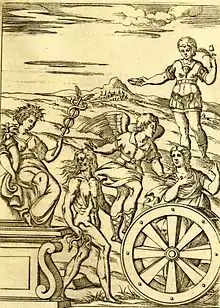.JPG.webp)
An Allegory of Truth and Time is a 1584–85 oil on canvas painting by Annibale Carracci, now on display in Hampton Court as part of the Royal Collection.[1]
It is not mentioned in any of the 17th century biographical sources on Carracci's life and it is thought to have been in England by the early 18th century at the latest. The first definite reference to it dates to the mid 19th century, by which time it was in Queen Victoria's collection[2] and thought to be by an unknown artist. Roberto Longhi and Hermann Voss assigned it its present attribution in the early 20th century.
Its style is very close to that of the artist's work on the Lives of Jason and Medea frescoes at the Palazzo Fava in Bologna, produced around 1584 with his relations Agostino Carracci and Ludovico Carracci.[3] For this reason it is sometimes argued that the canvas was commissioned by that palazzo's owner, Filippo Fava.[2] Its style and composition are both close to a drawing for a Judgement of Paris (Fogg Art Museum), argued by some art historians to have been produced by Carracci as a preparatory for a lost or never-executed painting.[4]
Iconography
%252C_Giudizio_di_Paride.jpg.webp)

Influences
One of the masterpieces of the painter's youth,[2] it reflects his reaction to Correggio's style, a reaction which marked his paintings immediately after entering the art scene.[3] Some argue that in this work that reaction is also filtered through the work of Federico Barocci.[3]
Gallery
%252C_Storie_di_Giasone_e_Medea%252C_Palazzo_Fava%252C_Bologna.jpg.webp) Annibale, Agostino and Ludovico Carracci, Lives of Jason and Medea, circa 1584, fresco, Palazzo Fava, Bologna
Annibale, Agostino and Ludovico Carracci, Lives of Jason and Medea, circa 1584, fresco, Palazzo Fava, Bologna Federico Barocci, Martyrdom of Saint Vitalis, 1583, Pinacoteca di Brera, Milan
Federico Barocci, Martyrdom of Saint Vitalis, 1583, Pinacoteca di Brera, Milan.jpg.webp)
References
- ↑ "Explore the Royal Collection Online". www.rct.uk. Retrieved 2020-06-15.
- 1 2 3 (in Italian) Daniele Benati, in Annibale Carracci, Catalogo della mostra Bologna e Roma 2006-2007, Milano, 2006, p. 164.
- 1 2 3 Donald Posner, Annibale Carracci: A Study in the reform of Italian Painting around 1590, London, 1971, Vol. I, p. 29.
- ↑ Donald Posner, Annibale Carracci: A Study in the reform of Italian Painting around 1590, London, 1971, Vol. II., N. 19, pp. 10-11.